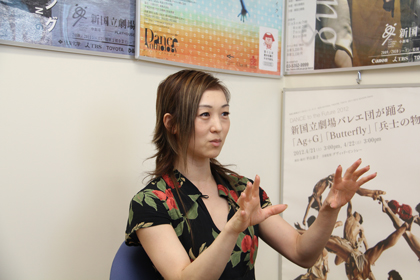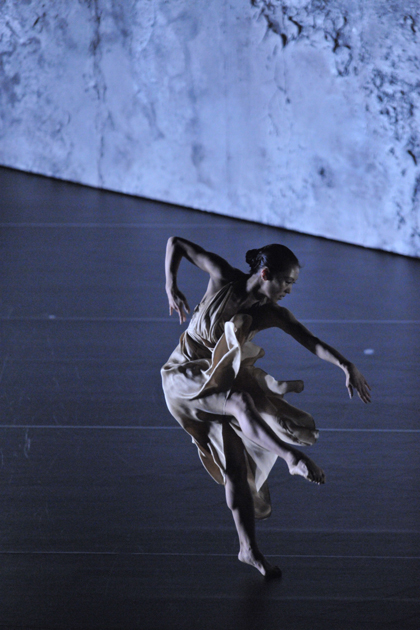TSUKUBA FRONTIER
#02 Contemporary Dance—A Physical Adventure Which Arouses Intellectual Curiosity
Humans have been instinctively expressing themselves through dance since before they developed language. This has gradually evolved and is now a contemporary culture, spanning entertainment, fitness and artistic creation, in which people enjoy themselves, compete and create.
Associate Professor HIRAYAMA Motoko, Faculty of Health and Sport Sciences

■ Why do people dance?
There is a culture of dance in every period in human history, every country and every ethnic group. It can be used for gratitude and prayer, to connect people, and for self-expression, while recently there has been a dramatic increase in the number of people using dance to stay healthy. Dance and physical self-expression are instinctive human impulses.
An encounter with dance is an enriching experience which brings out sensibilities and emotions concealed deep inside oneself, which in turn stimulate a new intellectual curiosity. It is said that the majority of human communication is not carried out through language, but through other means. In this sense, dance is a primitive and effective method for conveying, which facilitates versatile and free communication.
Dance is also a stage art, however, just like drama and opera. A performance is a continuum of time, space and movement, married to skillful use of costume, lighting, music and props. As this cannot be physically preserved, the phenomenon of dance cannot be guaranteed without the presence of an audience. Stage art comes about through a psychological connection created through discourse with the audience.
■ The appeal of contemporary dance

Contemporary dance, which has flourished since the 1980s, started to be noticed at around the same time as contemporary art. It is difficult to define, is not pinned down by rules, and knows no borders. Taken to extremes, we can say that it does not have to be staged in a theater, and anyone, regardless of experience or technique, can do it. Experimental challenges are also possible, such as collaborations with scientific and technological research. This is how far the aesthetics and sensibilities of dancers and choreographers are pushed. There is nothing safe or reassuring about these experiments - sometimes they are accepted by audiences, sometimes not. But creators know this. One of the attractions of contemporary dance is the ability to betray what conventional dance should look like and go off on an adventure.
The world of dance is undergoing change. We are in a transitional period--the greats of the twentieth century are gone, and the mantle has been passed on to the next generation. Even in traditional artforms, such as with the fusion of Japanese music and western dance, artists are experimenting with methods to bring them up to date. It is these 'slight mismatches' and repeated trial and error processes which help dance to evolve.
There will come a time when contemporary dance is evaluated by history, which is why it is important that people working hard in this field are noticed, so that the first half of the twenty-first century will be remembered as a period in which large numbers of people enjoyed dancing.
■ The university and dance

The fact that Prof. Hirayama specialized in dance and teaches it at the University of Tsukuba is significant. Acquiring an objective perspective, not just following choreographers' instructions and competing for technique, but thinking about how one should use their body, and understanding the differences between their physicality and that of others, is enormously beneficial in the pursuit of dance. It is also important for someone striving toward a career as a dancer to avoid turning dance into their entire world. They must see dance as one element within society and understand the role it must fulfil.
Prof. Hirayama thinks that being a member of the academic staff at the university gives her a platform from which to voice her opinions and means that she can provide opportunities for students and the next generation. Particularly because contemporary dance is but a small speck within the ocean that is dance and it is very difficult to turn it into a full-time job. The hope is that recognition of what Prof. Hirayama does both inside and outside the university will raise the profile of contemporary dance and open up paths for the new generation.
■ Proving the power of dance
Dance is a high-level stage artform backed up by rigorous physical training. It is similar to the martial arts in that one must develop powers of concentration, gain a deep understanding of one's body, and strive for supreme perfection in movement. It is a form of communication, a link between the body and the soul, in which the dancer and the audience share an imagination. It exceeds the realms of amusement and entertainment, captivates the emotions of the viewer and possesses the power to trigger change. Even people who believe they have no interest in dance will be impressed if they come to the theater.
Article by Science Communicator at the Office of Public Relations


